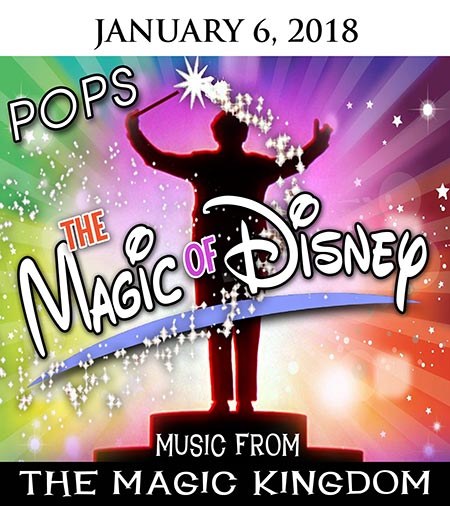Concert 3 “The Magic of Disney”
Music from the Magic Kingdom
January 6, 2018 7:30 PM
Wine & Cheese Reception 6:30 pm
Cailloux Theater – Kerrville, Texas
PERFORMANCES INCLUDE
A Disney Adventure – Sayre, arr
Conductor’s Letter
Dear Symphony of the Hills Community,
I wonder how many of us first experienced popular classical orchestral music watching cartoons or movies when we were growing up? So many people have shared this sentiment with me over the years. It is amazing in how many wonderful settings we find great symphonic pop music!
One individual who was very successful in bringing popular classical music to the masses was Walt Disney. He brought to life so many stories and characters to audiences of all ages through animation, beautiful orchestral music, and eventually his theme parks. Many of his joyful and beautiful animations were artistically and cleverly connected to great classical pops. Who can forget those magical broomsticks trying to keep the water away in Disney’s setting of The Sorcerer’s Apprentice. Of course, Paul Dukas’ intense music works as well as the brilliant animation in creating the suspense and excitement. And, his 1940 animated classic, Fantasia, was innovative for its visually creative connection to classical orchestral music, and was the first film ever made with stereophonic sound.
Disney’s work is celebrated all over the world, including his unequaled feat of earning 22 Academy Awards. Tonight’s concert performance features some great classical and modern pops music employed by Walt Disney in his classics, including tunes from Mary Poppins, Fantasia, and others.
We hope you enjoy the show!
Gene Dowdy
Conductor & Artistic Director
[sta_anchor id=”disney-concert-notes” unsan=”disney concert notes” /]Concert Notes
Symphony Concert January 6, 2018
The Magic of Disney
Many of us in the theater tonight were quite young when exposed, in the setting of a movie theater, to the fanciful artistry and craft of Walt Disney. He was a pioneer, innovator and visionary, a creator of moving images that told an exciting, engaging and primarily cheerful story. We were enthralled with the adventure and often learned something important and moralistic about life.
Walt Disney (1901–1961) was first an animator, then an American entrepreneur, voice actor and film producer. A pioneer of the American animation industry, he introduced several developments and patents for the production of cartoons. As a film producer, Disney holds the record for most Academy Awards earned by an individual, having won 22 Oscars from 59 nominations. He was presented with two Golden Globe Special Achievement Awards and an Emmy Award, among other honors.
Disney was the fourth son of Elias Disney, of Irish descent, and Flora (née Call), an American of German and English descent. When Disney was 4, the family moved to a farm in Missouri, where his uncle Robert had just purchased land. Disney developed an interest in drawing when he was paid to draw the horse of a retired neighborhood doctor. In 1911, the Disneys moved to Kansas City, Missouri, where Disney was introduced to the world of vaudeville and motion pictures, and took a correspondence course in cartooning.
The concert repertoire this evening has entertained large, enthusiastic audiences throughout the world. The program explores many of Walt Disney’s stories and characters through memorable melodies . . . excerpts from several fully staged Broadway productions and iconic Disney movies, including music from Fantasia (e.g., A Night on Bald Mountain, from a symphony by Mussorgsky, and Dance of the Hours (think dancing hippos,) from the opera La Giaconda by Ponchielli,) Mary Poppins and The Sorcerer’s Apprentice, based on the late-1890s symphonic poem by Paul Dukas.
In hearing the pieces in this concert we can reflect on the extent to which the quality of our lives have been enhanced by the talents of Walt Disney, whose name is synonymous with entertainment and fun.
Pomp and Circumstance, March No. 1
Edward Elgar (1857 – 1934)
Sir Edward William Elgar, 1st Baronet OM GCVO was an English composer, many of whose works have entered the British and international classical concert repertoire. Among his best-known compositions are orchestral works including the Enigma Variations and the Pomp and Circumstance Marches. The latter is of course familiar to all of us who have attended a graduation ceremony. Most relevant to this concert program, though, is the use of this Elgar piece in Disney’s Fantasia 2000.
Disney Magic
Bob Lowden, arr.
A Disney Supertime (from Mary Poppins
Bob Lowden, arr.
A Disney Adventure
Charles Sayre, arr.
Symphony No. 5, 1st Movement
Ludwig van Beethoven (1770 – 1827)
Symphony No. 5 is the first segment in the 1999 Disney animated film Fantasia 2000, accompanied by and synchronized with fantastic images that fit perfectly with the music. This segment of Fantasia starts without introduction immediately after the opening. Abstract patterns and shapes resembling butterflies in a range of colors and bats in black explore a world of light and darkness which is ultimately conquered by light.
The Sorcerer’s Apprentice
Paul Dukas (1865 – 1935)
The Sorcerer’s Apprentice is a symphonic poem by the French composer Paul Dukas, written in 1896–97. Subtitled “Scherzo after a ballad by Goethe”, the piece was based on Goethe’s 1797 poem of the same name. By far the most performed and recorded of Dukas’s works, its notable appearance in the 1940 animated film Fantasia (and again in the 1999 version) has led to the piece becoming widely known to audiences outside the classical concert hall.
In Fantasia, the sequence begins as an old sorcerer departs his workshop, leaving his apprentice with chores to perform. Tired of fetching water by pail, the not-yet-fully-trained apprentice casts an ill-advised spell on a broom to do the work for him. The floor is soon awash with water, and the apprentice realizes that he doesn’t know how to stop the broom. He splits the broom in two with an axe – but each of the pieces becomes a whole new broom that takes up a pail and continues fetching water, now at twice the speed. When all seems lost, the old sorcerer returns and quickly breaks the spell. The poem finishes with the old sorcerer’s statement that powerful spirits should only be called by the master himself. Indeed.
Night on Bald Mountain
Modest Mussorgsky (1839 – 1881)
Night on Bald Mountain, is from a series of compositions by Mussorgsky. It probably was inspired by Russian literary works and legend particularly concerning the theme of the witches’ sabbath on St. John’s Eve. Indeed, Mussorgsky completed the work on that very night, June 23, in 1867. In 1886, five years after Mussorgsky’s death, Rimsky-Korsakov published an arrangement of the work, described as a “fantasy for orchestra.” It is Rimsky-Korsakov’s version that Night on Bald Mountain achieved lasting fame. Premiering in Saint Petersburg in 1886, the work became a concert favorite.
In Fantasia, on the Witches’ Sabbath, Chernabog, god of evil, emerges from the peak of Bald Mountain to summon all of his minions, including ghosts, demons, hags and harpies, who dance furiously as he throws them into the mountain’s fiery pit. Chernabog is driven away by the light of the dawn, and a procession of figures walks up a hill to witness a sunrise. It is the last sequence in Fantasia and perhaps the most famous, or at least a close second to The Sorcerer’s Apprentice.
Dance of the Hours from La Giaconda
Ponchielli (1839 – 1881)
Dance of the Hours is a short and very familiar ballet piece first performed in 1876, the finale of the opera La Gioconda composed by Amilcare Ponchielli. It is meant to depict the hours of the day through solo and ensemble dances. In a short period after it was first released, the piece became one of the best known and most frequently performed ballets. Then, in 1940, its popularity attained unimaginable heights after Walt Disney included it in Fantasia as a very entertaining comic ballet featuring anthropomorphized ostriches, hippos, elephants, and alligators. It is fair to say that most of us who hear this very familiar piece of music will think of hippopotamuses in tutus.
Concert Notes by Jim Adams


